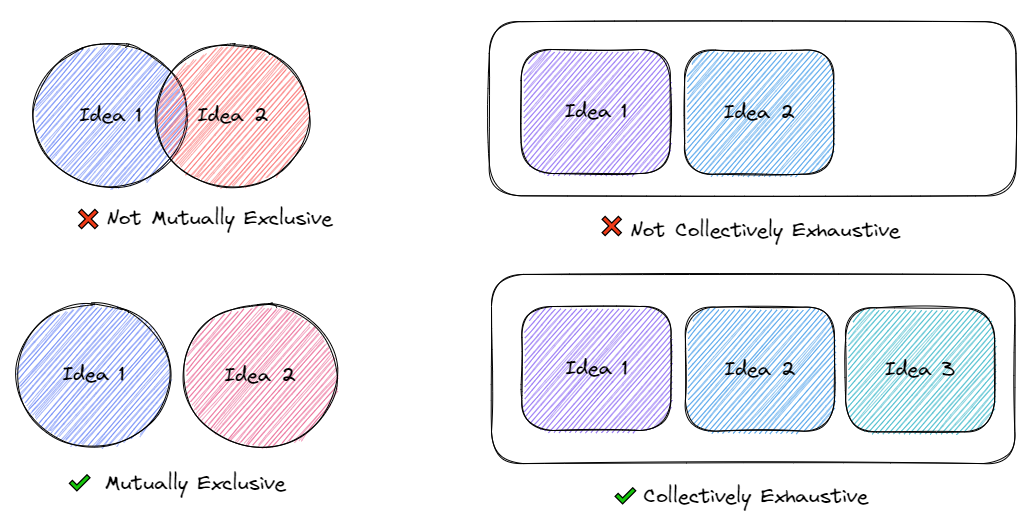In today’s rapidly evolving cloud landscape, having a reliable problem-solving technique is essential. That’s where MECE comes in. Let’s delve into the MECE method and uncover how it can empower you to tackle complex cloud challenges with ease and precision, making your job as a cloud architect more efficient and effective.
MECE: A Cloud Architect’s Best Friend
First things first, let’s demystify MECE. MECE stands for Mutually Exclusive, Collectively Exhaustive.
It’s a technique for breaking down a problem into smaller parts, making sure they don’t overlap (mutually exclusive) and that they cover every aspect of the problem (collectively exhaustive).
Imagine you have a collection of books from various genres, authors, and publication dates that you want to arrange on your bookshelf. Using the MECE technique, you can create distinct categories that do not overlap and ensure every book is accounted for.
For example, you might choose to categorize your books based on genres, such as:
- Fiction
- Non-fiction
- Biography
- Science Fiction and Fantasy
- Mystery and Thriller
By using the MECE approach, you can ensure that each book belongs to only one category (mutually exclusive) and that every book in your collection has a designated place on the shelf (collectively exhaustive). This will help you maintain an organized and easy-to-navigate bookshelf.

MECE: Mutually exclusive ideas or categories that are also collectively exhaustive.
It’s widely pronounced as MEE-see, but the original author Barbara Minto, a former McKinsey consultant, suggests it should be pronounced MEEce (rhyming with Greece).
I still prefer MEE-see though 😬.
Example: Applying MECE for Cloud Cost Optimization
So, how can the MECE technique come in handy for you as a cloud architect?
Let’s say your organization wants to save some money on its cloud infrastructure. As a cloud architect, your job is to seek out those areas where you can cut costs without skimping on performance, security, or reliability.
Time for the MECE technique! Break down the cost optimization process into neat, non-overlapping categories, so you don’t miss a thing.
Here’s how you might break up your cost optimization tasks:
- Resource Utilization: Check out how much compute, storage, and network resources you’re using. Find those sneaky overprovisioned or underutilized resources and tweak them to reach optimal resource allocation.
- Right-sizing Instances: Take a close look at the performance metrics of your cloud instances. Pick the most cost-effective instance types that still meet your performance needs.
- Data Transfer and Storage: Examine data transfer patterns and storage types. Optimize to cut costs with the help of content delivery networks, caching, or moving rarely accessed data to cheaper storage options.
- Scalability and Autoscaling: Set up scalable architectures and autoscaling solutions. Make sure you’re only provisioning resources when needed, scaling idle instances to zero, and trimming costs.
- Cost Monitoring and Analysis: Create a system to keep an eye on your cloud spending 24/7. Stay on top of resource usage, and make informed decisions about your cost optimization strategies.
With the MECE technique in your toolkit, you’ll craft a comprehensive and well-organized tech strategy for optimizing costs.
Each category will be crystal clear, allowing you to tackle every aspect of the cost optimization process and ultimately achieve a lean, mean cloud infrastructure.
Example: MECE and the 6th “R”
In my previous blog post on the 5 R’s of cloud rationalization, we already employed the MECE technique to uncover a 6th “R” that was absent from the conventional list of 5 R’s – Rehost, Refactor, Revise, Rebuild, and Replace.
By breaking down the various migration strategies into mutually exclusive and collectively exhaustive categories, we discovered the 6th “R”: Retain.
The 5 R’s list was not collectively exhaustive. The MECE technique helped us recognize this critical aspect of cloud rationalization that might have been overlooked otherwise!
Navigating Potential Pitfalls of MECE
While MECE offers numerous benefits, it’s essential to be aware of a few potential pitfalls when applying it to your architecture:
- Over-simplification: Be mindful not to lose sight of the bigger picture and overlook interdependencies between different aspects of the problem.
- Too many categories: Ideally, aiming for 3 categories is ideal, maybe 5 at most. Having too many categories defeats the purpose of the technique. It’s a balancing act against over-simplification.
- Difficulty in creating mutually exclusive categories: In some cases, it can be challenging to create completely distinct categories without any overlap. It’s essential to iterate and refine your categories to ensure they remain mutually exclusive while covering every aspect of the problem. Occasionally, as a last resort, creating an Other category can be appropriate.
- Time-consuming process: Applying MECE effectively may require a significant time investment, especially with complex cloud architecture issues.
Even with these pitfalls, the thought process that you go through attempting to apply MECE will time well spent.
Wrapping It Up
The MECE technique is a powerful tool for cloud architects, enabling us to break down complex problems into smaller, manageable parts. By ensuring that our categories are mutually exclusive and collectively exhaustive, we can be confident that we’re considering every aspect of a problem and not leaving any stone unturned.
So, next time you’re faced with a complex cloud architecture challenge, give the MECE technique a try. You might be surprised by the insights it can reveal and the efficiency it brings to your problem-solving process.
Feel free to drop your thoughts or questions to me on twitter @matttester.
